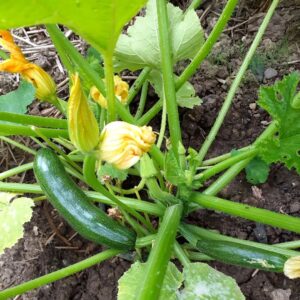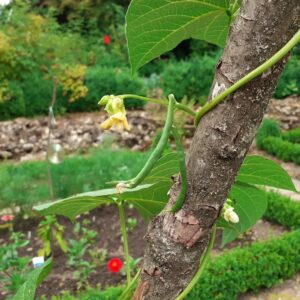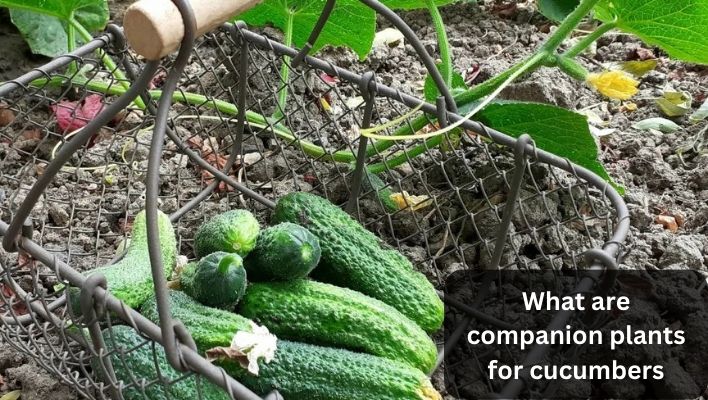What are companion plants for cucumbers? Have you ever wondered if there’s a secret to growing healthier, more bountiful cucumbers? Below, we’re diving into the fascinating world of companion plants for cucumbers.
If you’re unfamiliar with the concept, companion planting involves strategically pairing different plants to benefit one another. And let me tell you, it’s like a match made in gardening heaven.
Companion plants play a vital role in supporting cucumber plants by deterring pests, improving soil health, and enhancing overall growth. They’re like loyal sidekicks, helping cucumbers thrive and reach their full potential.
In this article, we’ll explore some popular companion plants for cucumbers, such as marigolds, nasturtiums, radishes, beans, and herbs. These incredible plants not only offer protection but also bring a touch of beauty to your garden.
So, get ready to unleash the power of companion plants and take your cucumber-growing game to a whole new level. Let’s start with the amazing benefits these companions can offer.
Why are Companion Plants Beneficial for Cucumbers?
When it comes to growing cucumbers, having a few trusty companions by their side can make all the difference.
Companion plants offer a range of benefits that promote the health and productivity of your cucumber patch. Let’s explore some specific advantages that these green partners bring to the table.
- Attracting Beneficial Insects: Certain companion plants, like marigolds and nasturtiums, act as natural magnets for beneficial insects. These little helpers, such as ladybugs and lacewings, feast on common cucumber pests like aphids and mites, keeping their populations in check.
- Repelling Pests: Companion plants possess natural defense mechanisms that repel unwanted pests. For instance, the pungent aroma of marigolds is unappealing to insects like nematodes and whiteflies, deterring them from infesting your cucumber plants.
- Providing Shade or Support: Some companion plants, such as tall-growing sunflowers or trellis-climbing beans, offer much-needed shade or vertical support for sprawling cucumber vines. This shading can help regulate soil temperature and prevent cucumber fruits from becoming sunburned.
- Enhancing Flavor and Growth: Believe it or not, companion plants can influence the taste and growth of cucumbers. For example, aromatic herbs like dill or oregano can impart a hint of their distinct flavors to nearby cucumbers, adding a delightful twist to your harvest.
- Pest Control and Disease Prevention: Companion plants also contribute to overall pest control and disease prevention. Their presence can confuse and deter pests from locating cucumber plants, reducing the likelihood of infestations. Additionally, diverse companion plantings create a more balanced ecosystem, minimizing the risk of diseases that tend to target a single plant species.
- Improved Pollination: Some companion plants, particularly flowering varieties, attract pollinators like bees and butterflies. These buzzing visitors ensure better pollination for your cucumber blossoms, leading to increased fruit sets and higher yields.
- Enhanced Nutrient Absorption: Certain companion plants, like legumes (e.g., beans), have a remarkable ability to fix nitrogen from the atmosphere. This enriches the soil with this vital nutrient, which cucumbers can then absorb, resulting in healthier and more vigorous growth.
By harnessing the power of companion plants, you create a harmonious garden ecosystem that promotes cucumber health, wards off pests, and boosts overall productivity.
The synergy between these plants offers a range of benefits, from pest control to improved pollination and enhanced nutrient absorption.
So, don’t be shy to incorporate some companion plants into the cucumber party and watch your harvest thrive. If you have a pepper garden check out these pepper companion plants to keep your grading glowing.

Companion plants for cucumbers
When it comes to growing cucumbers, finding the right companions can elevate your gardening game to new heights. Here’s a comprehensive list of companion plants that work wonders alongside cucumbers, along with their specific benefits and how they complement the growth of these refreshing veggies.
Marigolds:
Benefits:
Marigolds are renowned for their pest-repellent properties. Their distinct scent deters nematodes, aphids, and cucumber beetles, protecting your cucumbers from harm. Additionally, marigolds attract beneficial insects like ladybugs and lacewings, which prey on common cucumber pests.
Guidelines:
Plant marigolds around the cucumber patch to create a natural barrier against pests and invite helpful allies to your garden.
Nasturtiums:
Benefits:
Nasturtiums serve as excellent trap crops, diverting aphids away from cucumbers. Their vibrant flowers attract hoverflies, which feast on aphids, providing natural pest control. Furthermore, nasturtiums act as ground cover, shading the soil and reducing weed competition.
Guidelines:
Plant nasturtiums at the edges of your cucumber beds to deter aphids and add a pop of color to your garden.
Radishes:
Benefits:
Radishes act as natural soil aerators, breaking up compacted soil and creating pathways for cucumber roots. They also release chemical compounds that repel cucumber beetles, a common cucumber pest.
Guidelines:
Interplant radishes throughout your cucumber patch, spacing them at intervals to maximize their soil-loosening effects and deter pests.
Beans:
Benefits:
Beans are fantastic companions for cucumbers due to their symbiotic relationship. As climbers, beans provide natural trellising for cucumber vines, optimizing space usage. Moreover, beans are nitrogen-fixing plants, enriching the soil with this essential nutrient.
Guidelines:
Plant pole beans or runner beans along with cucumbers, allowing them to intertwine and share the vertical space while providing nitrogen for robust cucumber growth.
Herbs (e.g., Dill, Oregano):
Benefits:
Herbs like dill and oregano attract beneficial insects, such as predatory wasps and bees, which aid in pollination and pest control. They also provide shade and help deter pests with their aromatic properties.
Guidelines:
Intersperse dill or oregano among your cucumber plants, creating a fragrant and beneficial herb-cucumber mix.
Sunflowers:
Benefits:
Sunflowers provide shade and act as windbreaks for cucumber plants. Their towering presence helps protect cucumbers from excessive heat and strong winds.
Guidelines:
Plant sunflowers on the north side of your cucumber patch to provide shade and create a stunning visual backdrop.
Corn:
Benefits:
Corn plants offer vertical support for cucumbers to climb, especially for bush varieties. The cucumbers benefit from the structure provided by corn stalks, utilizing vertical space efficiently.
Guideline:
Plant corn in a row or block formation, leaving spaces for cucumbers to grow alongside them.
Borage:
Benefits:
Borage is a fantastic companion as it attracts pollinators, including bees and butterflies. It also improves overall plant health by accumulating potassium, calcium, and other minerals in its leaves.
Guidelines:
Plant borage near cucumbers to encourage pollination and boost plant vitality.

Chives:
Benefits:
Chives have natural fungicidal properties and help repel pests such as aphids and mites. They also attract pollinators and deter harmful insects.
Guidelines:
Grow chives near cucumbers to ward off pests and attract beneficial pollinators.
Lettuce:
Benefits:
Lettuce serves as a useful companion for cucumbers by providing shade to cucumber roots and reducing weed growth.
Guidelines:
Plant lettuce in between rows of cucumbers to optimize space and provide shade to the soil.
Calendula:
Benefits:
Calendula, also known as pot marigold, repels aphids, nematodes, and whiteflies. Its bright flowers attract pollinators and add a burst of color to the garden.
Guidelines:
Plant calendula around cucumber plants, either as a border or scattered throughout. Deadhead spent flowers to encourage continuous blooming.
Tips for successful companion planting with cucumbers
Companion planting with cucumbers can be a rewarding and fruitful experience. To ensure successful outcomes, consider the following practical tips and guidelines:
Spacing:
-
- Provide adequate spacing between companion plants and cucumbers to avoid overcrowding and competition for resources.
- Aim for a spacing of at least 12-18 inches between each plant to allow proper airflow and access to sunlight.
- Adjust spacing based on the specific requirements of companion plants and the available space in your garden.
Planting Arrangements:
-
- Integrate companion plants throughout the cucumber patch rather than confining them to a single area. This helps to distribute their benefits and create a balanced garden ecosystem.
- Consider planting taller companions, such as corn, sunflowers, or pole beans, on the north or west side of your cucumber patch to provide shade without casting excessive shadows.
- Interplant lower-growing companions, like marigolds, nasturtiums, or herbs, around the base of cucumber plants or along the edges of beds.
Timing:
-
- Start companion plants from seeds or transplants at the same time you plant your cucumbers. This allows them to grow together from the beginning and establish a harmonious relationship.
- Consider the maturity timelines of companion plants and cucumbers to ensure they can coexist throughout the growing season without one overshadowing the other.
Consider Potential Challenges:
-
- Be mindful of the growth habits and potential aggressiveness of companion plants. Some vigorous companions, such as sunflowers or pole beans, can overshadow cucumbers if not strategically positioned.
- Watch out for potential allelopathic effects, where certain plants release chemicals that inhibit the growth of neighboring plants. While uncommon with cucumbers, it’s good to be aware of any known interactions with specific companion plants.
Observe and Adapt:
-
- Regularly monitor your companion plantings and observe how they interact with cucumbers. Look for signs of competition, nutrient deficiencies, or pest infestations.
- Make adjustments as needed by thinning or relocating companion plants that are overpowering the cucumbers or causing negative effects.
- Embrace experimentation and learn from your garden’s unique conditions. Each season provides an opportunity to fine-tune your companion planting strategies.
By following these practical tips, you can create a thriving garden ecosystem where cucumbers and their companion plants coexist harmoniously.
Remember, companion planting is a dynamic process, and it may require some trial and error to find the perfect combinations that work best for your specific garden.

Companion plants for cucumbers FAQs?
Can I grow cucumbers with tomatoes as companion plants?
While cucumbers and tomatoes are often grown together in the same garden, they are not ideal companion plants. Tomatoes are susceptible to a soil-borne disease called Fusarium wilt, which can also affect cucumbers.
It is recommended to avoid planting them directly next to each other to minimize the risk of disease transmission.
However, if you have limited space, you can create a physical barrier between the two plants, such as using a trellis or installing a plastic sheet, to reduce the chances of cross-contamination.
Are there any plants I should avoid planting with cucumbers?
Yes, there are a few plants that are not recommended to be planted alongside cucumbers. These include potatoes, sage, and aromatic herbs such as mint and basil.
Potatoes can compete for resources and space with cucumbers, potentially hindering their growth. Sage and aromatic herbs may have allelopathic effects that can inhibit the growth of cucumbers.
It’s best to keep these plants separated to ensure the optimal growth and development of your cucumber plants.
How far apart should companion plants be spaced from cucumbers?
The spacing between companion plants and cucumbers depends on the specific needs of each plant. As a general guideline, provide at least 12-18 inches of space between companion plants and cucumbers.
This allows sufficient room for the plants to grow and ensures proper airflow and access to sunlight. However, always refer to the recommended spacing requirements for each plant to ensure optimal growth and avoid overcrowding.
Should I use companion planting for container-grown cucumbers?
Yes, companion planting can be beneficial for container-grown cucumbers as well. When growing cucumbers in containers, consider the size and growth habits of both the cucumbers and companion plants.
Select smaller companions, such as herbs like dill or marigolds, that won’t overcrowd the container. Allow enough space for each plant’s root system and provide appropriate support if needed.
Additionally, consider the watering and nutrient requirements of both cucumbers and companion plants to ensure they can coexist in the limited space of a container successfully.
Conclusion
Companion planting offers numerous benefits for cucumbers, enhancing their growth, health, and overall productivity. By strategically selecting compatible companion plants, you can create a thriving garden ecosystem that promotes natural pest control, improved pollination, and enhanced nutrient absorption.
To ensure successful companion planting, we have outlined practical tips and guidelines. Proper spacing, planting arrangements, and timing are crucial factors to consider.
We have also addressed potential challenges and highlighted the importance of observation and adaptability in creating a harmonious garden environment.
Furthermore, we have answered some frequently asked questions, addressing concerns about growing cucumbers with tomatoes, plants to avoid planting with cucumbers, spacing requirements for companion plants, and the suitability of companion planting for container-grown cucumbers.
Companion planting is a dynamic and ongoing experiment, requiring observation, adjustment, and the willingness to explore different combinations. By embracing this gardening technique, you can maximize the benefits for your cucumbers while creating a diverse and resilient garden ecosystem.
So, next time you plant cucumbers, consider their green allies in the form of companion plants. By fostering these symbiotic relationships, you will not only enjoy healthier and more abundant cucumber harvests but also contribute to the overall health and vitality of your garden.
